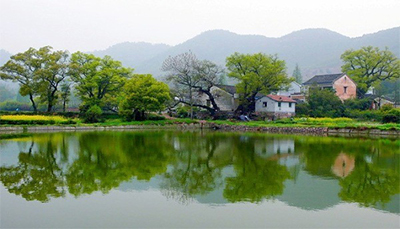



Spring scenery photographed in a village in Ningbo, East China's Zhejiang province. [Photo provided to chinadaily.com.cn]
Since the 18th National Congress of the Communist Party of China in late 2012, China has seen the trend of balanced regional development along with the implementation of a set of strategies, including the coordinated development of the Beijing-Tianjin-Hebei Region, the development in Yangtze River Delta Integration, the development of the Guangdong-Hong Kong-Macao Greater Bay Area, and the revitalization of old industrial bases in the northeast.
Driving on the scenic National Highway G318 from downtown Shanghai westward for one and a half hour, one will see swathes of paddy fields, fish ponds and watertowns built along small rivers on the vast Yangtze River Delta Integration. This is Jiangnan, literally south of the river. Associated with abundance and affluence, the term has been used since the ancient time to describe the delta, which mainly comprises Shanghai municipality and parts of Jiangsu and Zhejiang provinces.
At the border of Shanghai and its neighbors, a grand project called "Watertown Living Room" was launched on October 16th, 2021, in hope of building a "show house" to mark the second anniversary of the Yangtze River Delta's demonstration zone for integration and green development.
The Yangtze River Delta Integration was elevated to a national strategy by the State Council in 2018, and the demonstration zone was established in November 2019. Zhu Yiyuan, general manager of New Development Company of Yangtze River Delta Integration, said, "We will dredge the rivers and connect those once blocked waterways into a 'blue loop' around the Watertown Living Room area, linking different scenic and cultural sites." Besides the dredging, eight sub-projects were put into construction on October 16th, including waterfront greenery along the "blue loop" and three new roads to break dead ends on the borders.
In terms of industrial innovation, a new research and development center for semiconductors will be built and two existing science and technology parks will be upgraded. Zhang Zhongwei, deputy director of the executive committee of the demonstration zone, said the implementation of the Watertown Living Room project will prompt the creation of more innovative policies for inter-provincial coordination. Earlier October, the committee published a guideline of planning and construction, setting out a unified reference for environmental protection, architecture and the construction of transport facilities.
Though the Watertown Living Room project straddles different administrations, the committee wanted its development to follow one blueprint, by one major developer, and under one set of high-quality standards. Gao Ping, deputy director of the Shanghai ZhongChuang Institute for Industry & Innovation, a think tank focusing on regional development, said China's regional development often faces obstacles brought about by the separation of different administrative bodies. "The goal for the demonstration zone is to find a path to institutional innovation through coordination in concrete projects," he said, adding that many good practices in the integration of the Yangtze River Delta have been adopted in other regions, such as the Guangdong-Hong Kong-Macao Greater Bay Area and the Beijing-Tianjin-Hebei Region.
Edited by Wang Miao with reference to http://global.chinadaily.com.cn/a/202110/20/WS616f71d8a310cdd39bc7000b.html